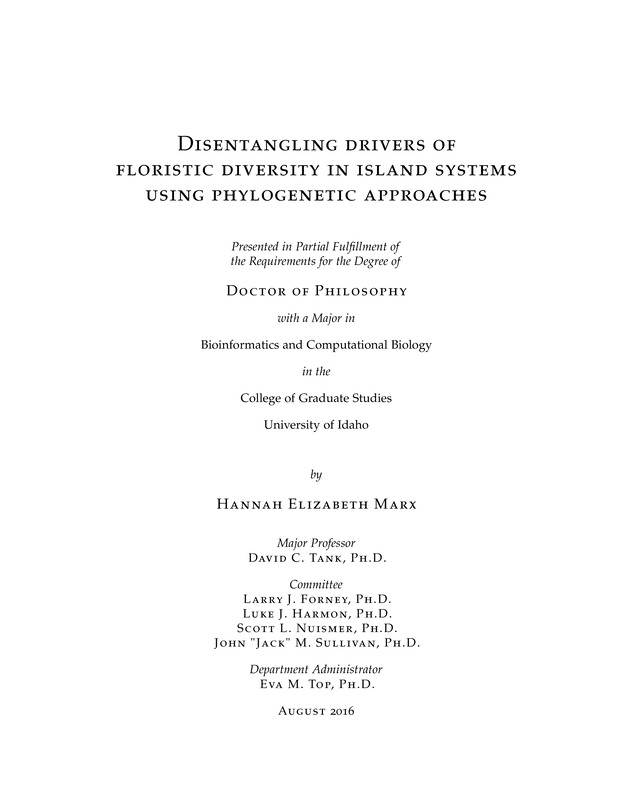Disentangling drivers of floristic diversity in island systems using phylogenetic approaches
Marx, Hannah Elizabeth. (2016). Disentangling drivers of floristic diversity in island systems using phylogenetic approaches. Theses and Dissertations Collection, University of Idaho Library Digital Collections. https://www.lib.uidaho.edu/digital/etd/items/marx_idaho_0089e_10882.html
- Title:
- Disentangling drivers of floristic diversity in island systems using phylogenetic approaches
- Author:
- Marx, Hannah Elizabeth
- Date:
- 2016
- Embargo Remove Date:
- 2017-08-16
- Keywords:
- alpine biogeography community phylogenetics France Idaho islands
- Program:
- Bioinformatics & Computational Biology
- Subject Category:
- Biology; Ecology; Bioinformatics
- Abstract:
-
The complexity of nature is awe inspiring. Identifying patterns is the first step towards understanding how this complexity arose and predicting what will come of it in the future. There are many ways to describe diversity. Measures that include phylogenetic diversity can provide a foundation for assessing hypotheses about ecological processes driving the patterns we observe. In this dissertation, I explore how incorporating the evolutionary history of coexisting species can help to disentangle patterns of diversity at macro-ecological scales. Islands have provided ideal study systems for evolutionary studies since the beginning of the field. I turn to the classical natural "experiments" that island-like systems provide, where many replicates of simplified microcosms represent the global variation in biology and geography.
I begin by introducing a few ways phylogenetic methods have been employed to understand diversity patterns, and discuss some of the challenges and pitfalls of this approach. I explain how evolutionary history can be used to interpret processes driving diversity in species assemblages at macro-scales when specific hypotheses are used with explicit null models. In summary, I postulate about how to improve the community phylogenetic approach with consistent comparable methods, more sophisticated null models, and novel datasets to quantify and qualify diversity.
Darwin's Naturalization Conundrum presents a clear hypothesis to address macro-ecological patterns of species invasion. In the second chapter, I quantify patterns in both functional trait differences and phylogenetic distances between invasive species and the native flora they invaded across 80 uninhabited islands in the San Juan Islands. I compare these trait-based and evolutionary distance-based measures of diversity, and discuss their implications for understanding invasion dynamics. Across the archipelago, invasives are closely related to natives but differ in ecologically relevant functional traits. These opposing trends may be informing particular stages in the invasion process.
Approaching the limits of plant life, mountains inspired Humboldt to synthesize his thoughts about how species diversity changes across space, and alpine summits constitute some of the last frontiers for biodiversity surveys. To understand the floristic patterns on pristine "sky islands" across the French Alps, I use nested species pools and explicit null models to assess the environmental, historical, and neutral processes that could contribute to the phylogenetic patterns we observe. Although extreme environmental conditions on mountain summits are expected to pose a strong filter and induce phylogenetic clustering of closely related species, we find that stochastic models of speciation, colonization, and local extinction can explain the phylogenetic patterns just as well. This demonstrates the importance of clear hypothesis testing to infer processes that generate phylogenetic diversity patterns.
The primary obstacle to a synthesis of phylogenetic patterns of diversity observed in natural communities or multi-lineage assemblies are comparable methods, especially for phylogeny reconstruction. In the final chapter, I introduce one novel approach for collecting sequence data for well-resolved community phylogenies. High-throughput sequencing approaches can be utilized to overcome one obstacle for describing diversity in remote regions---efficient genetic sequencing of entire species assemblages. I illustrate the efficacy of this approach by describing the diversity of a remote alpine flora in Central Idaho. Similar to the French Alps, stochastic patterns are dominant within and between summits. This suggests that although adaptations to extreme alpine environments drive diversity within particular lineages, species-neutral processes might dictate macro-ecological patterns at regional scales.
Together, these chapters exemplify how the evolutionary history of species assemblages can unravel dominant ecological and evolutionary processes that generate such elaborate complexity observed in nature. As more data are compiled and better models are developed, we continue to unify the patchwork of species distributions and might someday reach our ultimate goal---to provide a predictive framework for anticipating diversity dynamics across the globe.
- Description:
- doctoral, Ph.D., Bioinformatics & Computational Biology -- University of Idaho - College of Graduate Studies, 2016
- Major Professor:
- Tank, David C
- Committee:
- Forney, Larry J; Harmon, Luke J; Nuismer, Scott L; Sullivan, John M
- Defense Date:
- 2016
- Identifier:
- Marx_idaho_0089E_10882
- Type:
- Text
- Format Original:
- Format:
- application/pdf
- Rights:
- In Copyright - Educational Use Permitted. For more information, please contact University of Idaho Library Special Collections and Archives Department at libspec@uidaho.edu.
- Standardized Rights:
- http://rightsstatements.org/vocab/InC-EDU/1.0/

